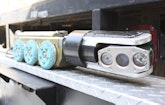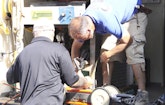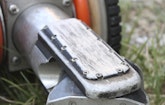Interested in Location/Detection?
Get Location/Detection articles, news and videos right in your inbox! Sign up now.
Location/Detection + Get AlertsThey wanted to be a one-stop-shop for problems with underground utility lines: to find it, fix it, and leave the client in excellent shape. Chief operations manager Shawn Helmer says the business plan called for a variety of equipment: push and mainline cameras, jetters, pipe bursting systems, CIPP lining, and point repair capability. Soon they added manhole rehabilitation and other remedial procedures.
“We knew we needed to be able to respond to customers with the latest in technology,” says Shawn Helmer. “With a camera and cleaning capabilities, you get your foot in the door to a lot of places.” The business concentrates on existing infrastructure rehabilitation and does not compete with big installation contractors.
Lean and versatile
Tony Helmer is the license holder, Patrick is chief financial officer, and Victor and Christopher are technicians, but all the brothers work right along with five other crew members. “Any one of us might be jetting one day, pipe bursting the next, and then backfilling a ditch,” says Shawn. “Titles aren’t critical in our ability to plug in the right person to fill a need. And that’s how we operate.”
The customer base is about 65 percent multifamily residential buildings, mobile home communities, townhouses and strip malls. Ten percent is in single-family residential, and the balance is industrial, commercial and municipal.
“We brought in pipe bursting fairly early in the equation,” says Helmer. “We knew it was definitely a revenue stream. Any trenchless technology we could offer would increase our chances of getting work fairly early.” The CIPP and sliplining systems, also added early on, enable repair of 4- to 60-inch lines, and larger if needed.
Cracked and crushed
Piping in the Tampa Bay region creates plenty of opportunity for repair. The sewer system, much of it in the ground for 40 years or more, includes clay tile, Orangeburg and asbestos piping. Storm drains include corrugated metal, concrete and plastic pipe.
“With Orangeburg, we see that the ground pressure has forced the pipe into an egg shape,” says Helmer. “When it loses a certain amount of roundness, the sidewalls no longer support it, and it is crushed. With clay and other tile, we see cracks and a lot of joint separation with root intrusion through those joints.”
The answer most frequently is pipe bursting and pulling in HDPE pipe. “When you need a single piece of pipe 400 feet long with no joints for roots to get in, you can use HDPE,” says Helmer. “We deal with 40- and 50-foot sticks, we fuse them together, and the weld is as strong as the pipe itself. It is a great product.”
Housing developments
Major projects often involve apartment complexes and mobile home communities, which may contain 300 to 700 units. Those projects can stretch out in phases over several years. Sometimes, owner associations schedule the work at times when most residents have left for the summer for properties in the North.
Typically, these projects involve 3- to 6-inch pipes. “The typical mobile home community dates back to 1965, and they are not tending to build new ones,” says Helmer. “Generally you have all your utilities – water, sewer, electric, phone and cable – in a small, confined easement, usually running behind the homes. The utilities have in large part been ignored.”
Other major projects include repair of storm drains with rusted and corroded metal pipe and concrete pipes with joint separation. The solution in most cases is sliplining with HDPE. “It’s a very versatile product,” says Helmer. “With the smooth interior of the pipe, you can reduce the size of the pipe and increase the flow.
“You can go from a 36-inch pipe down to a 28-inch HDPE pipe and not reduce the pipe’s ability to carry water. Flow increases with less friction inside the pipe. We can move water faster when we slipline the pipe. For the larger storm sewer repairs where an open dig is not feasible and CIPP lining won’t work due to the conditions within the host pipe, our preferred method of pipe replacement is sliplining.”
For lateral lining projects, Subterrain uses the MaxLiner USA system, designed for 3- to 10-inch lines.
Manhole rehabilitation for municipal clients addresses problems unique to Florida. “Here we often have a high water table and a lot of infiltration,” says Helmer. “The temperatures down here cause hydrogen sulfide to attack the structure. It’s an accelerated deterioration due to climate and related conditions.
“We use Machine Technologies mixing and mortar pumping equipment to do the repair with structural mortars from Inflow Solutions. Work ranges from rebuilding the benches to actually rebuilding the walls of the manholes to their original thickness.”
Eyes underground
The Subterrain fleet consists of eight vans and trucks. A 2001 Ford E450 box van carries mainline inspection equipment from Cobra Technologies, including 6- and 8-inch Cobra crawlers. A 1985 Grumman box van is outfitted with pipe bursting equipment from TRIC Tools and the MaxLiner lateral system.
Push cameras include models from UEMSI, Vivax-Metrotech Corp. and Ratech Electronics, plus a black-and-white pan-and-tilt unit from Wiggerich Warenwirtschaft, and a black-and-white SeeSnake camera from RIDGID. Other items include:
Locators from Schonstedt Instrument Co. and Vivax-Metrotech Corp.
Leak detection equipment from UE Systems (Ultraprobe 2000) and Subsurface Leak Detection
Model 4018 trailer-mounted waterjetter from US Jetting with 4,000 psi/18 gpm pump, 600-gallon water tank, and removable 400-gallon tank
Model 139-304 large electric-powered manhole tripod with lowering basket from Lisbon Hoist
Combination sewer cleaning trucks are rented when needed, and Tony and Shawn operate them. The company works out of a 40-year-old, 4,000-square-foot steel building with offices, meeting rooms and ample storage and yard space.
Many-faceted
The company policy is that all technicians are trained on all aspects of the equipment, although the mainline camera truck is operated solely by Christopher Helmer.
When looking for technicians, the brothers target people who are willing and eager to learn and solve problems on their own ingenuity. “You can go in with a plan, but the plan you finally use may not be the plan you started with,” says Helmer.
“Everything we deal with was first done by someone else. You may be trying to do a pipe bursting job, but 15 years ago there was a break in the pipe and somebody poured in concrete. That concrete will capture the bursting head. The technician has to decide what to do. We need people who can think and problem-solve. Every single job is different.”
Helmer says even a camera can’t reveal everything that is under the ground. For example, soil conditions five to seven feet down can be unpredictable, and technicians have to be able to adapt.
“Our technicians can fill in anywhere,” Helmer says. “With as many things as we have going on, you have to use what you have at hand. We don’t want to have to think that someone can or can’t be on this or that kind of job. Everybody is valuable and everybody is useful.”
Planning the work
Tony and Shawn Helmer plan the job schedule on a two-week calendar. A given job may involve two to five people. On a recent project in Missouri, three technicians worked for seven days in a wastewater treatment facility near Lake of the Ozarks, applying Rubberseal waterproof coating from Inflow Solutions to the walls of tanks that had been leaking.
About 5 percent of the company’s work is for emergencies. “You never know when the phone will ring, and they need you right then,” says Helmer. “We respond. We try to plan jobs in advance, but we have the leeway and flexibility to plug something in on a moment’s notice. That presents an opportunity to show the customer they made the right phone call.”
Emergency calls roll into Helmer’s line, and he makes the decision on the proper response. “It’s based on the caliber of emergency,” he says. “A lot of times, people only think they have an emergency. You have a conversation and determine what they are hoping to get out of the call.
“If in fact they have an emergency, and I consider it an emergency, I call an employee and say, ‘I need you at the shop in 15 minutes.’ Our employees all know that getting such calls is a part of the job. We get to the shop and mobilize based on the needs of the particular customer, and then we leave from the shop.”
Safety first
Because of the company’s many underground services, all technicians receive extensive safety training, including OSHA confined-space entry and OSHA Competent Person training. “Manhole rehabilitation almost always requires some form of confined-space work,” says Helmer. “Every time we go into a manhole, it is treated as confined space, and we do that quite often.”
Helmer says new technology definitely “sweetened the pot” when he and his brothers considered opening their own business, taking out home-equity loans, and getting some financial backing from their parents. He sums it up, “Subterrain Technologies gave us the freedom to chart our own path.”














